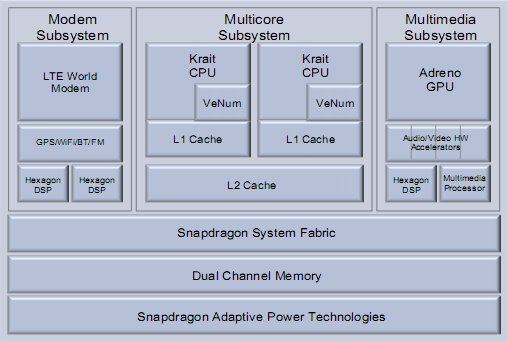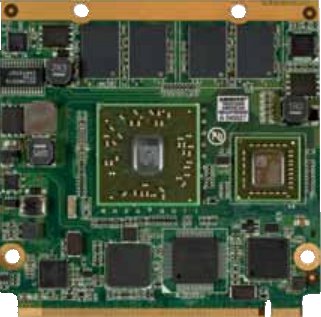When you configure a program before building, it will usually check for dependencies and if one is missing it will return an error such as: checking for OPENSSL… configure: error: Package requirements (openssl) were not met: No package ‘openssl’ found Consider adjusting the PKG_CONFIG_PATH environment variable if you installed software in a non-standard prefix. It could be a PATH issue, but usually that simply means the development version of the library is not installed. Sometimes the name is easy to guess and can be installed with apt-get: sudo apt-get install packagename-devel But sometimes it’s more difficult to guess and Google is not always very helpful. In that case you can use aptitude to search for the package. For example for nss3: sudo aptitude search nss3 i libnss3 – Network Security Service libraries i libnss3-1d – Network Security Service libraries p libnss3-dbg – Development files for the Network Security p libnss3-dev […]
Qualcomm Snapdragon S4: MSM8960
Qualcomm initially announced the Snapdragon S4 is a blog post back in August. They have now released a white paper providing further information on this processor. The Qualcomm Snapdragon S4 (MSM8960) is composed of two Krait CPUs clocked between 1.2 and 1.5 Ghz, an Adreno 225 GPU and a modem subsystem with LTE, GPS, Wifi, Bluetooth and FM support. It will be manufactured using 28nm technology and provide much lower power consumption compared to previous generations. Key features and improvements: New CPU micro-architecture: The Krait CPU offer a 60% performance improvement compared to the scorpion CPU used in previous generations. SIMD/VFP performance: Multimedia instructions (SIMD) and floating point operations have also been improved, but no metrics have been provided. Optimized memory subsystem: Krait includes dual-channel memory. Dual-channel memory is critical in order for the processor to being able to handle the large bandwidth requirements in multicore systems. 25/40% power improvement: […]
Embedded Linux Conference Europe 2011
Embedded Linux Conference Europe (ELC-E 2011) will take place on October 26 – 28, 2011 at Clarion Congress Hotel in Prague, Czech Republic. The event will be co-located with LinuxCon Europe 2011 and GStreamer Conference. The day before the official opening of the conference, two tutorials will be offered on Tuesday 25th of October:b Outside the Box: An Introduction to Embedded Linux and Hardware Interfacing Using the Snowball Board – 9:00 – 17:00 – Trainer: Chris Simmonds – Cost: 350 USD. Embedded Android Workshop – 9:00 – 17:00 – Trainer: Karim Yaghmour- Cost: 300 USD. ELCE consists of 3 days of presentations, tutorials and sessions. There will be over 50 sessions during those 3 days. I’ll highlight a few sessions that I find particularly interesting. October 26 10:45 – 11:45 – Linaro’s Android Platform by Zach Pfeffer, Linaro Android Platform team leader. Linaro uses components from the Android Open Source […]
Dropbear: Lightweight SSH Server / Client
You may need to remotely access your embedded device, or your embedded systems is simply headless. You could use telnet, but this is insecure. A secure way to access a device remotly is to use SSH protocol. OpenSSH is one implementation but this is relatively too large and may use uncesary space on a device with limited storage. That’s where Dropbear comes into play. Dropbear is a lightweight implementation of an SSH client and server and is ideal for embedded systems. Dropbear ARM executable is only 200 KB. Here’s how it’s described on its website: Dropbear is a relatively small SSH 2 server and client. It runs on a variety of POSIX-based platforms. Dropbear is open source software, distributed under a MIT-style license. Dropbear is particularly useful for “embedded”-type Linux (or other Unix) systems, such as wireless routers. The main features of dropbear: A small memory footprint suitable for memory-constrained […]
Cross-comping zlib for ARM target
Zlib is defind as “A Massively Spiffy Yet Delicately Unobtrusive Compression Library” and used in many projects requiring compression. Here are the instructions cross-compile zlib for ARM: Download zlib1.25 wget http://cdnetworks-kr-2.dl.sourceforge.net/project/libpng/zlib/1.2.5/zlib-1.2.5.tar.gz Extract it tar xzvf zlib-1.2.5.tar.gz cd zlib-1.2.5 Configure, build and install zlib. CC=armv5tel-redhat-linux-gnueabi-gcc ./configure –prefix=/home/jaufranc/edev/rootfs make make install This will install libz.a (static library) and libz.so (dynamic library) in /home/jaufranc/edev/rootfs/lib and copy the header files to /home/jaufranc/edev/rootfs/include.
Installing an ARM Toolchain in Fedora
You can easily install an arm cross-compiler on Fedora as follows: cd /etc/yum.repos.d/ sudo wget http://ftp.linux.org.uk/pub/linux/arm/fedora/cross/cross.repo sudo yum install armv5tel-redhat-linux-gnueabi-gcc You can check the installation worked by checking the cross-compiler version [jaufranc@localhost ~]$ armv5tel-redhat-linux-gnueabi-gcc -v Using built-in specs. Target: armv5tel-redhat-linux-gnueabi Configured with: ../configure –prefix=/usr –mandir=/usr/share/man –infodir=/usr/share/info –enable-shared –enable-threads=posix –enable-checking=release –with-system-zlib –enable-__cxa_atexit –disable-libunwind-exceptions –enable-languages=c,c++ –disable-libgcj –with-sysroot=yes –enable-version-specific-runtime-libs –target=armv5tel-redhat-linux-gnueabi Thread model: posix gcc version 4.1.2 20070925 (Red Hat 4.1.2-33.fa1) This will only install the C compiler (gcc), to install the C++ compiler, run the following command: sudo yum install armv5tel-redhat-linux-gnueabi-gcc-c++ Tested in Fedora 12.
AMD G-Series QSeven Module Conga-QAF by Congatec
Congatec announced the Conga-QAF, a Qseven module powered by AMD G-Series embedded processors. The module will come with either the AMD G-T40R single core or the AMD G-T40E dual core processor, with 2 GB DRAM by default (expandable to 4GB), numerous I/O interfaces and an optional on-board SSD with a capacity of up to 32 GB. If you are not familiar with the QSeven Form Factor and why it is used, please read the beginning of the blog post entitled “QSeven Form Factor Embedded Boards by Seco“. To summarize, this is a standard to allow developers to use modules (based on QSeven specs) to test their software on several processors by inserting those modules in a common main board. Here are the specification of the Conga-QAF Qseven module: CPU AMD G-T40E 1.0 GHz Dual Core (L1 cache 64KB, L2 cache 512kB x2, 6.4 W) AMD G-T40R 1.0 GHz Single Core […]
60 USD Android Tablet: Aakash UbiSlate 7 Tablet
After much delay, the low cost tablet promised by the Indian government is finally released. The Aakash UbiSlate 7 is designed primarily for Indian students and will be sold to them at a discount. The tablet will be manufactured by Datawind in Hyderabad, India. The retail price will be 2,999 Rupees (~61 USD), but it will be sold to the government for 2250 Rupees (~46 USD) and will end up in the hands of students for a sponsored price of 1300 Rupees (~26 USD). Here are Aakash UbiSlate 7 Tablet Specifications: Processor: 366MHz Conexant Processor Memory: 256MB RAM Storage: 2GB Flash memory + 2GB Micro SD card (expandable to 32GB) OS: Android 2.2 with Getjar Marketplace (not the default Android Marketplace) Display: 7″ resistive touchscreen Network: Wifi only. Later models will be GPRS and SIM enabled. USB: 2 x ports Audio out: 3.5mm jack / Audio in: 3.5mm jack Battery: […]










